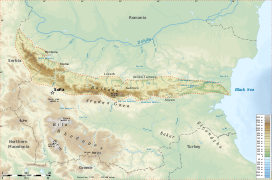
Back Balkangebirge ALS Monts Balcans AN Hæmus ANG جبال البلقان Arabic جبال البلقان ARZ Montes Balcanes AST Balkan dağları Azerbaijani Балҡан тауҙары Bashkir Балканскія горы Byelorussian Стара планина Bulgarian
| Balkan Mountains Stara Planina | |
|---|---|
| Haemus Mons | |
 A view from Kom Peak in western Bulgaria | |
| Highest point | |
| Peak | Botev Peak |
| Elevation | 2,376 m (7,795 ft)[1] |
| Listing | List of mountain ranges |
| Coordinates | 42°43′02″N 24°55′02″E / 42.71713°N 24.91716°E[1] |
| Dimensions | |
| Length | 557 km (346 mi) west-east |
| Width | 15–50 km (9.3–31.1 mi) north-south |
| Area | 11,596 km2 (4,477 sq mi) |
| Naming | |
| Native name | |
| English translation | 'Old Mountain' |
| Geography | |
 | |
| Countries | |
| Range coordinates | 43°15′N 25°0′E / 43.250°N 25.000°E |
| Geology | |
| Rock types |
|
The Balkan mountain range[2] is located in the eastern part of the Balkans in Southeastern Europe. The range is conventionally taken to begin at the peak of Vrashka Chuka on the border between Bulgaria and Serbia. It then runs for about 560 kilometres (350 mi), first in a south-easterly direction along the border, then eastward across Bulgaria, forming a natural barrier between the northern and southern halves of the country, before finally reaching the Black Sea at Cape Emine. The mountains reach their highest point with Botev Peak at 2,376 metres (7,795 ft).
In much of the central and eastern sections, the summit forms the watershed between the drainage basins of the Black Sea and the Aegean. A prominent gap in the mountains is formed by the predominantly narrow Iskar Gorge, a few miles north of the Bulgarian capital, Sofia. The karst relief determines the large number of caves, including Magura, featuring the most important and extended European post-Palaeolithic cave painting, Ledenika, Saeva dupka, Bacho Kiro, etc. The most notable rock formation are the Belogradchik Rocks in the west.
There are several important protected areas: Central Balkan National Park, Vrachanski Balkan, Bulgarka and Sinite Kamani, as well as a number of nature reserves. The Balkan Mountains are remarkable for their flora and fauna. Edelweiss grows there in the region of Kozyata stena. Some of the most striking landscapes are included in the Central Balkan National Park with steep cliffs, the highest waterfalls in the Balkans and lush vegetation. There are a number of important nature reserves such as Chuprene, Kozyata stena and others. Most of Europe's large mammals inhabit the area including the brown bear, wolf, boar, chamois and deer.
The mountains are the source of the name of the Balkans (sometimes considered as a distinct peninsula or region). In Bulgarian and Serbian the mountains are also known as Стара планина Stara planina (pronounced in Bulgarian as [ˈstarɐ pɫɐniˈna] and in Serbian as [stâːraː planǐna]), a term whose literal meaning is 'old mountain'.[3]
- ^ a b "Topographic map of Botev Peak". opentopomap.org. Retrieved 2023-05-18.
- ^ (Ancient Greek: Αἵμος, Latin: Haemus; Bulgarian and Serbian: Стара Планина) known locally also as Stara Planina Николов, Васил С. [Vasil S. Nikolov]; Йорданова, Марина Д. [Marina D. Ĭordanova] (1997). Планините в България [The mountains of Bulgaria] (in Bulgarian). Sofia, Bulgaria: Prof. Marin Drinov Publishing House of the Bulgarian Academy of Sciences. p. 7. ISBN 954-430-029-5.
- ^ Bulgaria. 1986.
